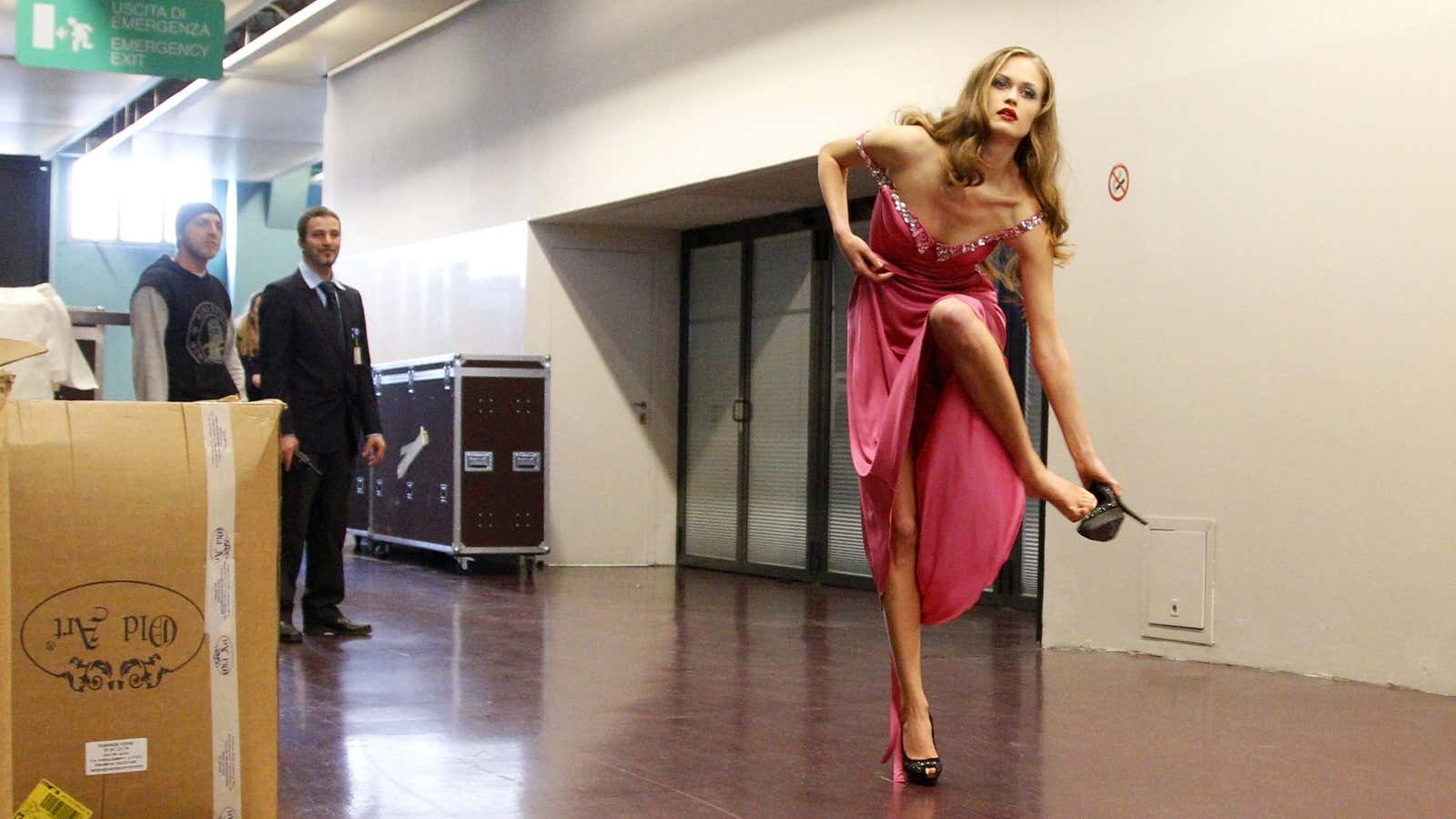The comedian Henry Youngman was famous for his one-liners. In one of his better-known jokes, a patient visits the doctor. “Doctor, it hurts when I do this,” the patient says, to which the doctor replies: “Don’t do that!”
As leagues of women will attest, it hurts to wear high heels. “They’re so painful,” actress Emma Thompson proclaimed on stage at the 2014 Golden Globes, martini in one hand and red-soled Louboutin heels in the other. “And pointless, really. You know, I really would like to urge everyone to stop it. Just stop it. Don’t wear them anymore.”
Women, however, are nowhere near ready to give them up. Even as clothing steadily evolves toward the comfortable and functional, and we increasingly live in yoga pants and sneakers, high heels retain their powerful atavistic allure.
Despite the advice of Youngman’s doctor and Thompson, “don’t do that” is evidently not an option. But like any problem in need of solving, the scenario presents an attractive business opportunity: What if you could make a comfortable high heel?
One new contender trying to fashion that holy grail of women’s footwear has emerged from Google’s prestigious accelerator program and lately secured the support of Nina Garcia, the creative director of Marie Claire magazine and a Project Runway judge. True Gault, named after founder Sandra Gault, believes its novel approach makes for a better-fitting—and yes, comfortable—high heel. “Our high heels fit like a glove with no pain, pressure or teetering,” the site boldly declares.
Better shoes through technology
The way True Gault aims to achieve this near-miracle is through technology: You use their iPhone app to take pictures of your foot. (It’s only available on Apple’s phones at the moment.) The app generates a 3D model of the foot, and the company’s algorithmically powered “fit formula,” honed on thousands of scans of women’s feet, determines the shoe’s dimensions.
Each shoe is unique, meaning even the left foot and right foot are different, unless your feet themselves happen to be exactly the same. But True Gault says it has found that one foot is roughly half a size different from the other, in either width or length, in about 97% of the thousands of individuals the company has scanned.
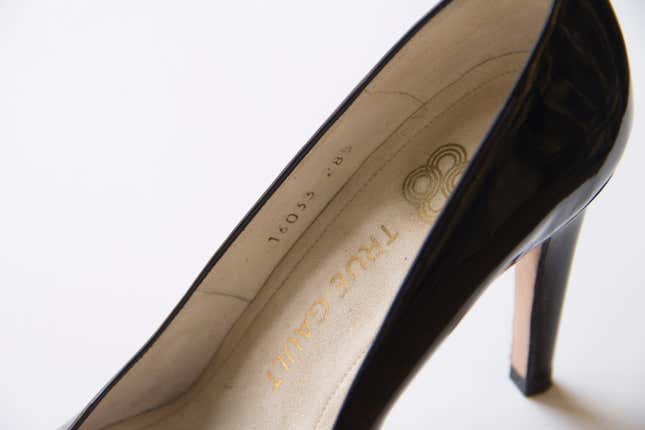
“There’s no perfect size 8 out there,” Gault says, which is why the company abandons the notion of standard sizing altogether. Instead, each customer gets their own unique serial number, which also lets the company identify that shopper in future orders.
Once scanned, you choose the style of your shoe from about 20 available, the type of leather you’d like—there are around 40 of those—and the heel height you prefer. Most of True Gault’s heels come in 2-inch or 4-inch varieties. Within four weeks, you have your new heels. They’re made at True Gault’s partner factory in Spain, and start at $250, skipping the retail markup like other internet-enabled, direct-to-consumer brands.

When you get your shoes, you can provide feedback on the fit, allowing True Gault to adjust your next pair of shoes accordingly. Gault says every new pair of shoes you buy will fit even better than the last. It’s a smart tactic to encourage repeat orders, and the company says at this stage more than 30% of its customers are returning buyers.
And because each shoe is customized to each of your feet, True Gault promises the fit and feel is unlike anything else. “We follow the biomechanics of the person’s foot,” Gault says. “The weight is evenly distributed across the bottom of the foot.”
The agony and ecstasy of heels
This last point seems to defy physics. The suffering caused by high heels may include toe pinching or skin chafing, but the primary culprit is that your elevated heels force your weight disproportionately onto the fore of your foot. To stay upright, and somehow walk in this precarious tip-toe, requires adjusting your entire body.
“High heels alter the natural alignment of your spine and put you at a higher risk for developing back pain,” explains Dr. Chetan Patel, medical director of the Spine Health Institute. “Use of high heels requires your lower-back muscles to work harder.”
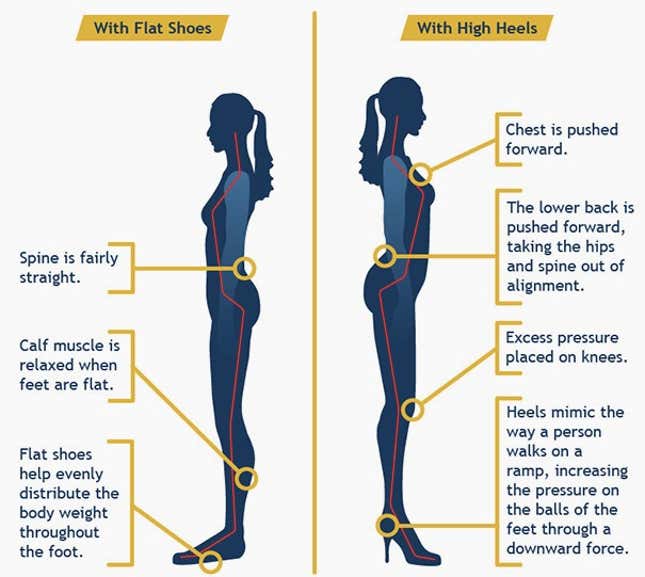
Heels can also put more stress on your calves, knees, and hips, and according to Dr. Patel, studies show that over time their use can result in what’s called swayback, an unhealthy posture in which your hips are perpetually thrust forward and your lower back arched, molding your profile into an attenuated S shape. The higher the heel the greater the effect. (Dr. Patel recommends frequent heel wearers work on strengthening their cores and doing exercises to keep their spines flexible to minimize the impact.)
The posture that heels force a woman to assume, however, is also the secret of their attraction. They make the wearer push out the chest and raise the rear, exaggerating those sex-associated features.
A team of psychologists from the UK have even proposed a theory that heels tap into human evolutionary biology. Women, their argument goes, naturally have a different stride and gait than men. Heels emphasize those differences. They make women walk more like women.
“As smoking is to human breath, so the stiletto is to a woman’s stride,” fashion personality and former Vogue editor André Leon Talley told New Yorker contributor Mary Karr. Glamor aside, smoking is, of course, a known health hazard, so it’s an apt analogy.
The willingness to suffer physically for the sake of appearance seems to be common among heel wearers. In a 2014 survey (pdf) of 1,000 US adults by the American Podiatric Medical Association, high heels ranked as the number-one cause of foot pain, yet the survey also found that the average woman who owned heels had nine pairs.
“Even I find it hard to purchase attractive shoes with heels less than three inches high!” Dr. Constance Chu, a professor of orthopedic surgery at Stanford University—and author of a study on the way heels prematurely age your knees—told Shape magazine last year.
So why the hell do women wear high heels?
“We’ve been doing it for centuries, so I don’t think that’s going to change anytime soon,” Gault replied when asked why she thinks women continue to wear heels, despite the discomfort they inflict. “But I’ll tell you why we do it. We wear high heels because they look sexy on us.”
She also pointed out that heels are the de facto business footwear of women in the US and many other places today. Gault’s own background is in digital imaging technology. She worked at Kodak and IBM before getting the idea for True Gault, and has found other businesswoman enthusiastic about it. She secured her spot in the Google accelerator program, which provides startups with support and mentorship, after running into some Google employees at an event and telling them about her idea. “The Google women went crazy,” she said. They told her about the accelerator. True Gault got in, and has been working with the program since January. (Google did not reply to a request for comment.)
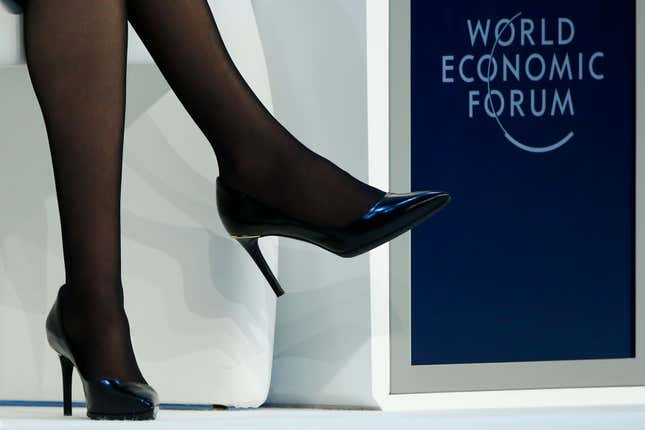
Those impulses—to be sexy and to be professional—don’t always coexist easily. Even if dress codes are breaking down, heels are still a necessity in some workplaces, as PricewaterhouseCoopers in London emphasized when it sent home a female employee for having the mind-melting audacity to turn up in flats instead of heels. Yet those heels also need to follow a set of unspoken cultural rules. “For many women at work, high heels convey a polish of professionalism,” Quartz’s Jenni Avins wrote in a story about the dueling effects of heels. “But in academia, as in many conservative professional environments, a heel that’s ‘too high’ can convey a message of frivolity: The wearer can’t be serious, or even smart.”
The various connotations of heels have mutated repeatedly over the centuries of the high heel’s existence. Initially, they were men’s footwear, invented in Persia, historians believe, and brought to Europe by Persian cavalrymen and traders in the 17th century. Europeans elevated their status, as the heel elevated the wearer, and they became the footwear of aristocracy. Gradually women adopted them as well. When, in the 19th century, men cast off as feminine the rich fabrics and bold colors that once signified privilege, heels went out too. They became the sole province of women.
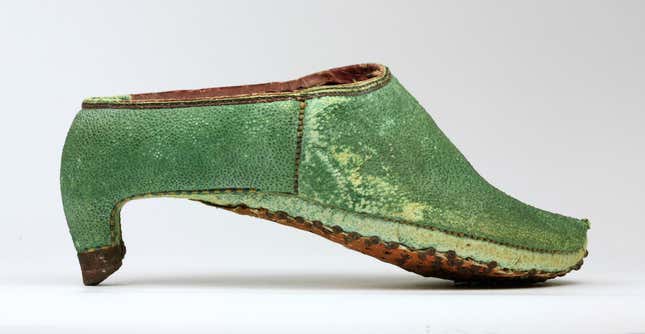
The more recent past becomes more complicated. In The Atlantic last year, Megan Garber wrote about another startup, Thesis Couture, out to make the world’s first comfortable stiletto heel with the aid of a literal rocket scientist and a former astronaut, and dove into the complex symbolism and psychology of high heels today. Stilettos, Garber explains, were a fixture in 19th century pornography. That image of a seductive woman in skinny heels helped set the visual format for some of the advertising and pin-up photography that would follow in the 20th century.
Stiletto heels weren’t something you could walk in, however, until modern steel production allowed designer Roger Vivier to debut his needle heel, and its stem of extruded steel, in 1954. The wooden heels fashioned prior couldn’t support a person’s weight. Despite the stiletto’s scandalous past, it became standard for housewives before falling out of fashion for a period, only to be resurrected in the 1980s as the footwear of choice for music stars such as Tina Turner and women entering the workforce, embodied by actress Melanie Griffith in the 1988 movie Working Girl.
All those connotations still seem to be jostling about in every high-heeled step. Much as heels accentuate certain features on a woman, they also seem to emphasize her motivation for wearing them. Specifically because they hurt, they’re unlikely to be something a woman throws on for a day without thinking. A woman has to want what the high heel is offering, which can be simultaneously sexy and conservative, a sign of individual empowerment or conformity.
Can they ever be comfortable? True Gault thinks so. But it—and others—face an uphill battle. For now, however, Gault says they have no shortage of women interested. “One shoe at a time, one step at a time, we started collecting customers,” she says. “We’ve got thousands of people scanned, hundreds and hundreds of customers.”
